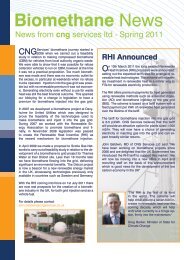Bio-SNG - CNG Services
Bio-SNG - CNG Services
Bio-SNG - CNG Services
You also want an ePaper? Increase the reach of your titles
YUMPU automatically turns print PDFs into web optimized ePapers that Google loves.
BIO-<strong>SNG</strong> FEASIBILITY STUDY – ESTABLISHMENT OF A REGIONAL PROJECTFigure 6.6 & Figure 6.7, show the cost breakdown (£/MWh) for the large facilities. When fuelled bywoodchip, the capital cost and the biomass costs are both similar, and dominate over the operationalcost. At £40/MWh, the RHI is substantially more significant than either the capital or feedstock elements.When fuelled by SRF, the capital cost dominates, since the fuel is no longer a cost but provides a smallcontribution to the revenue stream. In this case, the lower biogenic fraction reduces the value of the RHI,and although this is still an important factor in viability, the SRF case will be slightly less sensitive to theabsolute level of the RHI.6.3.1 EscalationThe above analysis is “real” and considers 2010 gas prices. In the future, gas prices are likely to escalateat a different rate from inflation, as may biomass prices. In its analysis for the RHI (February 2010)DECCdoes not attempt to consider wholesale biomass prices out to 2020 for the purposes of large scale powergeneration “The prevalence and preference for long term contracts, with companies establishing bilateralcontracts with suppliers, makes it difficult to establish a clear relationship between price and feedstockcosts. There are also far more feedstock types, and fewer generators in the electricity sector, hence atypical supply chain could not be constructed. Furthermore, it is more uncertain how this sector willdevelop in the future.”Progressive Energy is of the view that biomass prices are likely to move at least in line with natural gas(and may possibly increase faster if the pressure on biomass resources increases both in the UK andinternationally). This does conflict with the prevailing DECC view which believes biomass will becomecheaper relative to natural gas. Clearly DECC‟s position would indicate a long term decrease in <strong>Bio</strong>-<strong>SNG</strong>outturn cost compared with prevailing gas prices, and therefore improvements in the economic outlook fora project.However, even if biomass prices were to increase in line with natural gas, and other costs were to remainconstant, the price of <strong>SNG</strong> would reduce relative to natural gas since the feedstock only represents ~50%of the production cost. For example, using DECC‟s central case, natural gas is believed to increase by15% by 2020 (in real terms) to ~68p therm. This would result in only an ~8% increase in the <strong>Bio</strong>-<strong>SNG</strong>price ie 67p/therm for the woodchip case. However using DECC‟s “high” case, natural gas wouldincrease by 50% in real terms, resulting in only a 25% increase in the <strong>Bio</strong>-<strong>SNG</strong> Cost to 77p/thermcompared with a natural gas price of 97p/therm, ie still improving the economic outlook for <strong>Bio</strong>-<strong>SNG</strong>.In reality the non-feedstock costs (investment and operational costs) are also likely to increase to adegree (in light of prevailing energy price increases and an international appetite for low carbon projects),somewhat softening this improvement.55









